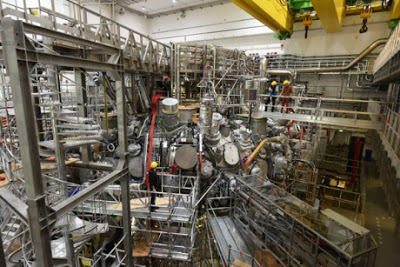Assembly of the Wendelstein 7-X – the world’s largest stellarator-type fusion device – at the Max Planck Institute for Plasma Physics (IPP) in Greifswald, Germany, began in April 2005 and was completed in April 2014. The operational preparations have been under way ever since.
On 10 December, the operating team in the control room started up the magnetic field and initiated the computer-operated experiment control system. It fed around one milligram of helium gas into the evacuated plasma vessel and switched on the microwave heating for a short 1.3 MW pulse. The first plasma could be observed by the installed cameras and measuring devices.
The first plasma in the machine had a duration of one-tenth of a second and achieved a temperature of around one million degrees Celsius.
The next task will be to extend the duration of the plasma discharges and to investigate the best method of producing and heating helium plasmas using microwaves.
Wendelstein 7-X is to operate for two years without active cooling, during which time it will be able to operate for about 50 seconds at 1 MWt, or at 8-10 MW for 5-10 seconds. The machine will then undergo an 18-month shutdown when it will be fitted with an actively cooled divertor for heat fluxes of up to 10 MWt per meter squared. This will bring Wendelstein 7-X to its full steady state capacity.

Brian Wang is a Futurist Thought Leader and a popular Science blogger with 1 million readers per month. His blog Nextbigfuture.com is ranked #1 Science News Blog. It covers many disruptive technology and trends including Space, Robotics, Artificial Intelligence, Medicine, Anti-aging Biotechnology, and Nanotechnology.
Known for identifying cutting edge technologies, he is currently a Co-Founder of a startup and fundraiser for high potential early-stage companies. He is the Head of Research for Allocations for deep technology investments and an Angel Investor at Space Angels.
A frequent speaker at corporations, he has been a TEDx speaker, a Singularity University speaker and guest at numerous interviews for radio and podcasts. He is open to public speaking and advising engagements.


